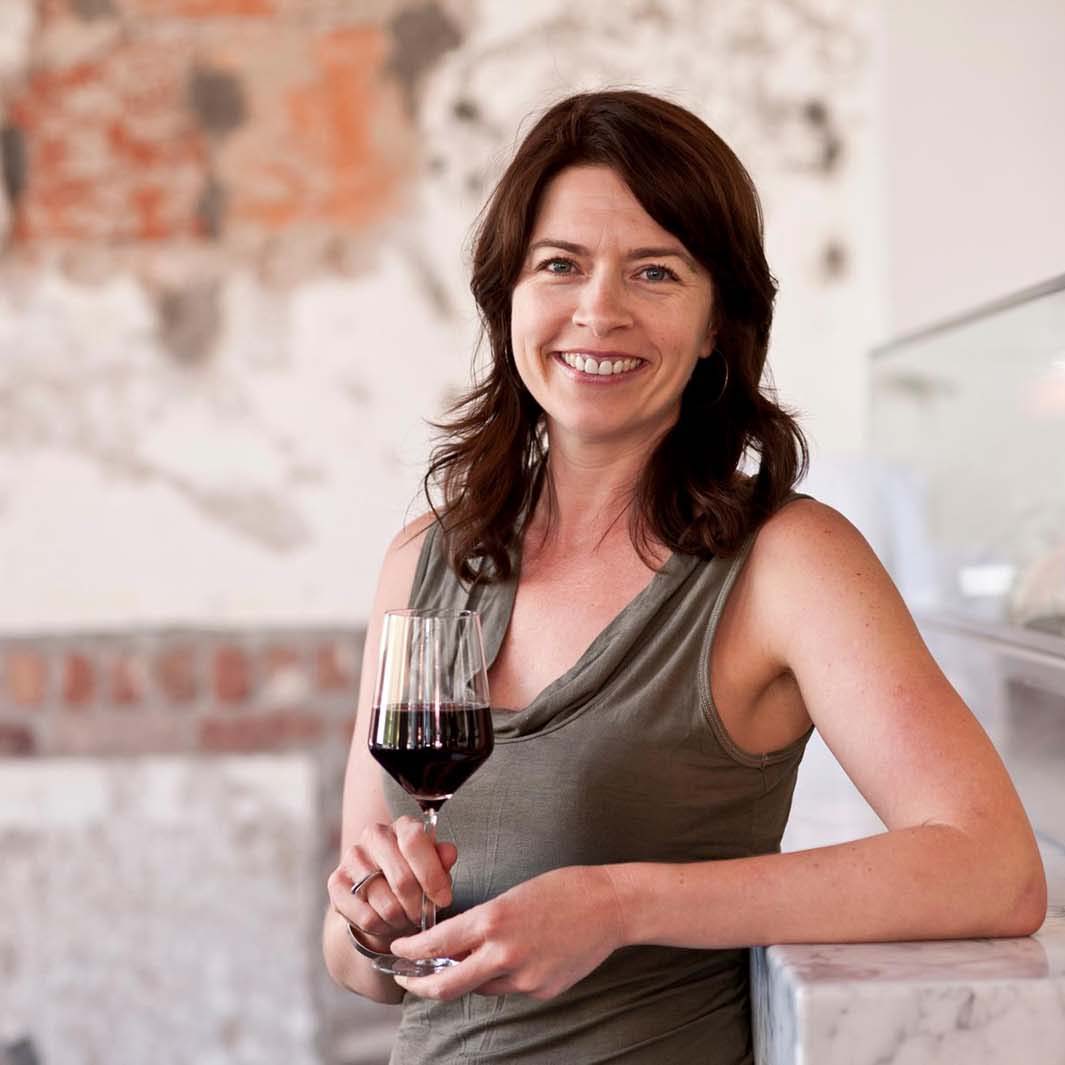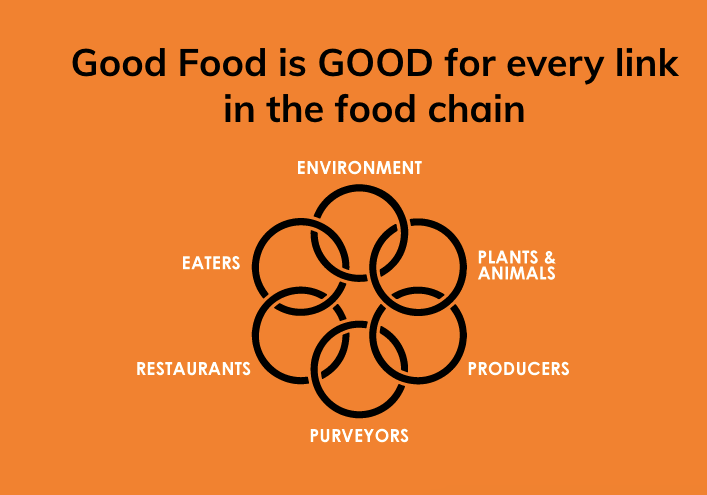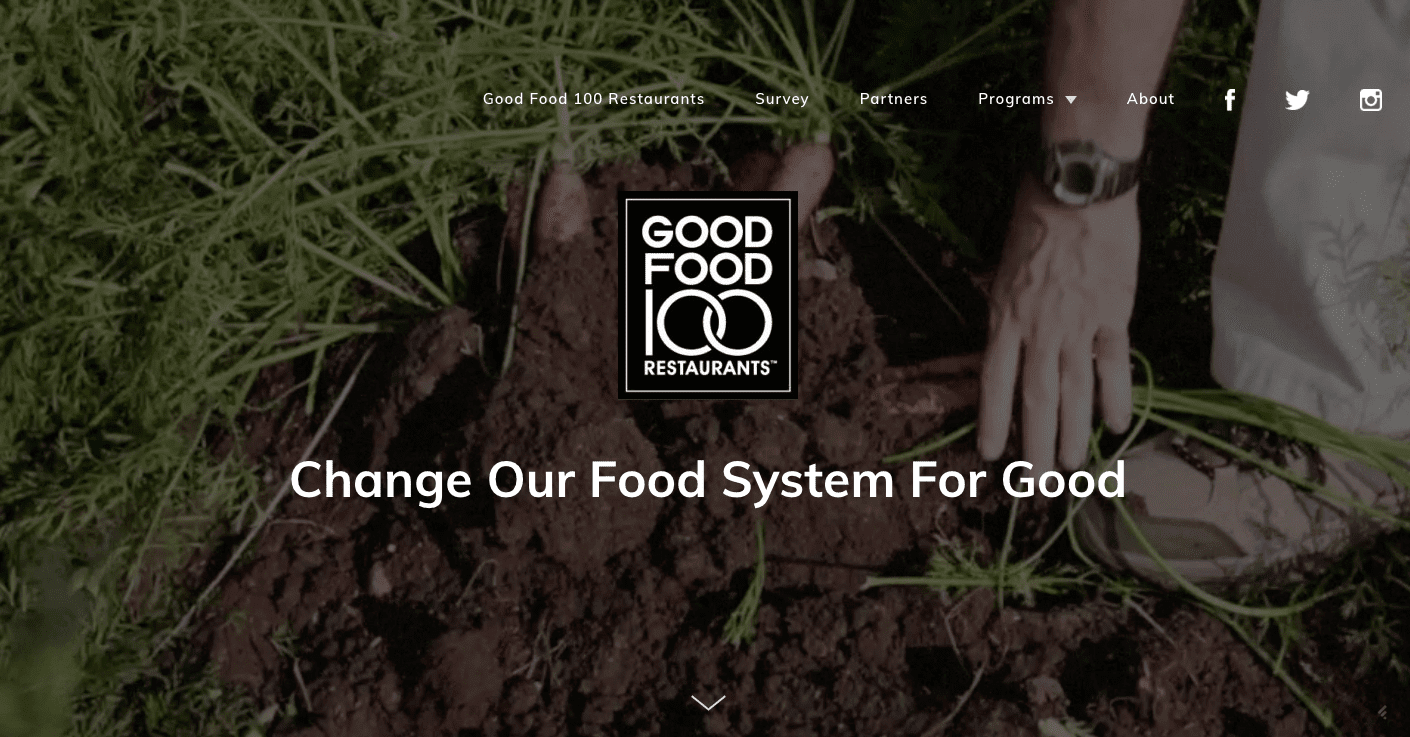Sara Brito on Why Good Chefs Care About “Good Food”

Slow food pioneer and former executive director of Chefs Collaborative, Sara Brito, is kicking off an exciting new way to evaluate restaurants and food service businesses.
Good Food 100 Restaurants, a new rating system, focuses not on flavor but on how much money is spent on “good food,” (food that is good for all links of the food chain). Read on to find out how Sara Brito went from fashion to good food and how each and every one of us can nudge the food system in the right direction.
You started your career in retail/e-commerce marketing. How did you get interested in sustainable/slow food?
I went to Syracuse University where I studied communications at the Newhouse School of Public Communications, one of the top communications schools in the country. My program emphasized ideas and big thinking with a focus on the conceptual and strategic aspect of communications. I knew that I wanted to live in New York City but advertising agency salaries at the time were hovering around $18,000 to $20,000 a year, which would have been very difficult to support myself on.
So, I started talking to some packaged goods companies, but I didn’t want to live in Ohio. The Mays Department Stores Company (now Federated Department Stores, Inc.) was recruiting on campus and pitching their executive training program, which I decided to join. I’ve always had an interest in food and fashion because they are both expressions of people’s identities. You are what you eat and you are what you wear.
This was the 1990s and I was starting the internet division for Bloomingdales. It was my first step in my game changer mentality; I don’t want to be doing the status quo within a company or industry. I want to be focused on where we are going.
Retailing turned out to be my version of business school. I learned about business, Excel spreadsheets and how to use numbers to tell a story—how to use numbers to build a case for change.
You had the idea for Good Food 100 Restaurants while working on an economic impact analysis of seven Denver-area restaurants. From concept to about to release your first ratings, how did it come to be?
I feel very blessed. I was fortunate enough to be introduced to my co-founder Jeff Hermanson who is a successful entrepreneur in Denver and is also the founder of the Crested Butte Wine & Food Festival. Denver-based chef Alex Seidel had been involved in the festival and wanted to use it as an opportunity not to just serve indulgent food but as an opportunity to inspire thinking and conversation. I was invited to a meeting to brainstorm his idea. It happened to come at a really busy time in my schedule but I remember thinking to myself, “Invitations like this are door openers.” I always try to approach those invitations with a yes mindset. At the brainstorm, I met Jeff and later in the course of throwing out some ideas he suggested he hire me to run this for him. Good Food 100 Restaurants started as a little project. That little project eventually grew into this.
Where does the 100 come into play?
Part of our inspiration is from the Fortune 100 list or the Inc. 5000 list. The latter started as a list of 100 companies and has grown to 5,000. Like Good Food 100 Restaurants, the Inc. 5,000 involves a survey as well and businesses self-report revenue that is then verified. We will never limit ourselves to 100 restaurants. Eventually, we hope that we will have thousands, but we will always shine the spotlight on the top 100.
How does Good Food 100 Restaurants define “good food”? Is this your personal definition of good food?
“Good food” was not defined by my personal definition of good food, but it definitely reflects it. In many ways, my personal definition is stricter and has higher standards.
It’s an amalgamation of many definitions. For example, we pulled from definitions from Slow Food, Chefs Collaborative, Seafood Watch, and Animal Welfare Approved to name a few. I imagine that the current definition will evolve and grow over time as thinking and standards change.
Our goal was to establish a minimum threshold that was accessible to a wide variety of restaurants and food service businesses that would represent a move in the right direction: If a restaurant or food service business practiced the minimum threshold they would make a positive impact on the food system.
Take the meat category, for example. We could have a debated the right definition of “good food” until the cows came home. We will likely never agree on one right definition. So we asked, “What would be the one thing that would have a positive impact on the food system?” We decided that two standards would have a tremendous impact: Not purchasing meat with sub-therapeutic antibiotics or from caged animals.
Our standards our not perfect, our surveys are not perfect, but when the analysis comes out we hope that we’ve at least chosen reasonable definitions that are nudging us to a better food system.
I like to use the analogy of trying to lose 10 pounds: You are not going to lose 10 pounds if you keep buying bags of potato chips. You are also not going to lose those 10 pounds by just not buying the potato chips. But the action of not buying the potato chips nudges you in the right direction. You have to put your money where your mouth is.

The goal of the program is to “Redefine how chefs and restaurants are viewed and valued”. How are you hoping this manifests into real-world change?
For most chefs, their real power is in their purchasing. And making small changes in their purchasing can have a huge impact. Purchasing is also within chefs control. In our current political climate, we can all complain about what we need our representatives to do. But I love the people and organizations emphasizing what is still within our control. It prevents us from sliding into victim mode.
If we focus on the things that are in our control, we feel empowered. When we are empowered, we take action, and by taking action, we see those baby steps. And when we see all the baby steps everyone has made we see that we’ve made a real difference.
Eating is so much about taste and enjoyment. Does taste/culinary prowess factor into this?
There are already so many great brands and organizations that are focused on and recognize the culinary and craft aspect of cooking, which we will be pulling into our website. For example, we will note on a restaurant’s page if they have received recognition including a James Beard Award or a Star Chefs Rising Stars or Bon Appetit’s Hot Ten. Until now, the recognition driving the industry has been primarily based on taste. We are here to create something different, to change the way people view and value restaurants, focusing on the whole story of the food.
I was recently at the James Beard Awards and it was so great to see so many of the chefs that took our survey be recognized: Suzanne Goin, Rick Bayless, and Steven Satterfield to name a few. When a chef like Rick Bayless wins Outstanding Restaurant of the year for Topolobampo and has also had a lifelong commitment to “good food,” it says that good food is at the center of the industry conversation today. Good chefs care about “good food.”
When it comes to evaluating seafood sourcing practices, where do you see the gaps or pitfalls?
I actually don’t know. What I’m really interested in is seeing what the data tells us about what is possible in the supply chain. How much food is it possible to source in the various regions? I’m very in interested in the potential.
What I hear over and over again from chefs is, “I think I’m doing a good job, but I don’t know.” No one sees each other’s numbers so there is no way to gauge how well you’re doing.
The ratings are really the first high-profile program of the Good Food Media Network. What are your hopes/plans for the future?
The first step was to get the survey out, the second step was encouraging participation, and the third is announcing the list in June 2017. From there, we’re hosting Eat Drink Think at the Crested Butte Wine & Food Festival. The focus will be Surf & Turf 2.0. The way we’ve been approaching meat and seafood, what I call 1.0, isn’t working. We’ll be thinking about and discussing what 2.0 looks and tastes like. The event includes TED-style talks and a panel discussion—with nationally known experts, thought leaders, and chefs—and dinner.
Also, the 2018 survey goes live in January 2018. From there, we’re open to how things can evolve.
